汽车防抱死制动系统(ABS)
- 格式:doc
- 大小:121.00 KB
- 文档页数:14
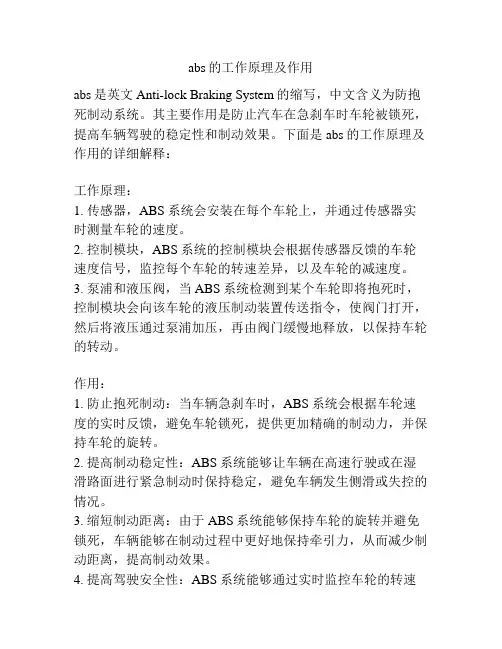
abs的工作原理及作用
abs是英文Anti-lock Braking System的缩写,中文含义为防抱死制动系统。
其主要作用是防止汽车在急刹车时车轮被锁死,提高车辆驾驶的稳定性和制动效果。
下面是abs的工作原理及作用的详细解释:
工作原理:
1. 传感器,ABS系统会安装在每个车轮上,并通过传感器实时测量车轮的速度。
2. 控制模块,ABS系统的控制模块会根据传感器反馈的车轮速度信号,监控每个车轮的转速差异,以及车轮的减速度。
3. 泵浦和液压阀,当ABS系统检测到某个车轮即将抱死时,控制模块会向该车轮的液压制动装置传送指令,使阀门打开,然后将液压通过泵浦加压,再由阀门缓慢地释放,以保持车轮的转动。
作用:
1. 防止抱死制动:当车辆急刹车时,ABS系统会根据车轮速度的实时反馈,避免车轮锁死,提供更加精确的制动力,并保持车轮的旋转。
2. 提高制动稳定性:ABS系统能够让车辆在高速行驶或在湿滑路面进行紧急制动时保持稳定,避免车辆发生侧滑或失控的情况。
3. 缩短制动距离:由于ABS系统能够保持车轮的旋转并避免锁死,车辆能够在制动过程中更好地保持牵引力,从而减少制动距离,提高制动效果。
4. 提高驾驶安全性:ABS系统能够通过实时监控车轮的转速
差异和减速度,帮助驾驶员避免急刹车时发生滑动、失控等意外情况,提高驾驶安全性。
5. 增加操控性:由于ABS系统能够保持车辆稳定并防止车轮锁死,驾驶员在制动时能够更好地控制车辆,提高操控性和可靠性。
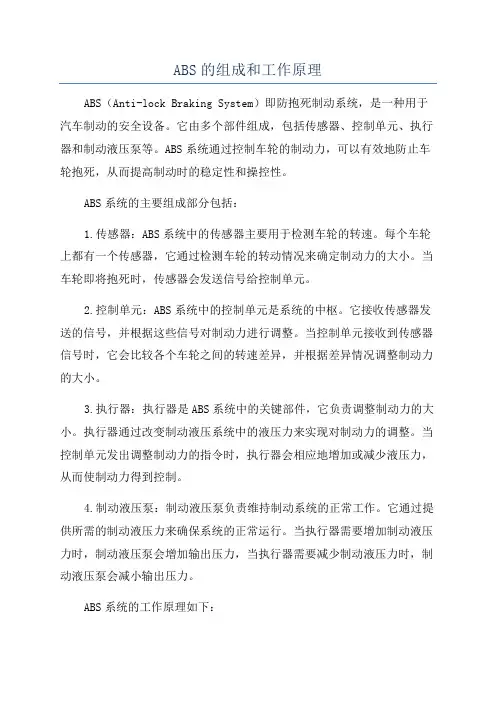
ABS的组成和工作原理ABS(Anti-lock Braking System)即防抱死制动系统,是一种用于汽车制动的安全设备。
它由多个部件组成,包括传感器、控制单元、执行器和制动液压泵等。
ABS系统通过控制车轮的制动力,可以有效地防止车轮抱死,从而提高制动时的稳定性和操控性。
ABS系统的主要组成部分包括:1.传感器:ABS系统中的传感器主要用于检测车轮的转速。
每个车轮上都有一个传感器,它通过检测车轮的转动情况来确定制动力的大小。
当车轮即将抱死时,传感器会发送信号给控制单元。
2.控制单元:ABS系统中的控制单元是系统的中枢。
它接收传感器发送的信号,并根据这些信号对制动力进行调整。
当控制单元接收到传感器信号时,它会比较各个车轮之间的转速差异,并根据差异情况调整制动力的大小。
3.执行器:执行器是ABS系统中的关键部件,它负责调整制动力的大小。
执行器通过改变制动液压系统中的液压力来实现对制动力的调整。
当控制单元发出调整制动力的指令时,执行器会相应地增加或减少液压力,从而使制动力得到控制。
4.制动液压泵:制动液压泵负责维持制动系统的正常工作。
它通过提供所需的制动液压力来确保系统的正常运行。
当执行器需要增加制动液压力时,制动液压泵会增加输出压力,当执行器需要减少制动液压力时,制动液压泵会减小输出压力。
ABS系统的工作原理如下:当驾驶员踩下制动踏板时,ABS系统会自动监测车轮的转速。
如果传感器检测到一些车轮的转速明显低于其他车轮,表明该车轮即将抱死。
这时,控制单元便会接收到传感器的信号,并根据信号信息进行处理。
控制单元首先会比较各个车轮之间的转速差异,如果差异过大,即表明有车轮即将抱死。
为了避免车轮抱死,控制单元会发出相应的指令,通过执行器来调整制动力。
执行器根据控制单元的指令调整制动液压力。
当车轮即将抱死时,执行器会减少制动液压力,以使制动力减小,从而避免车轮抱死。
当车轮的转速恢复正常时,执行器会恢复制动液压力,保持适当的制动力。
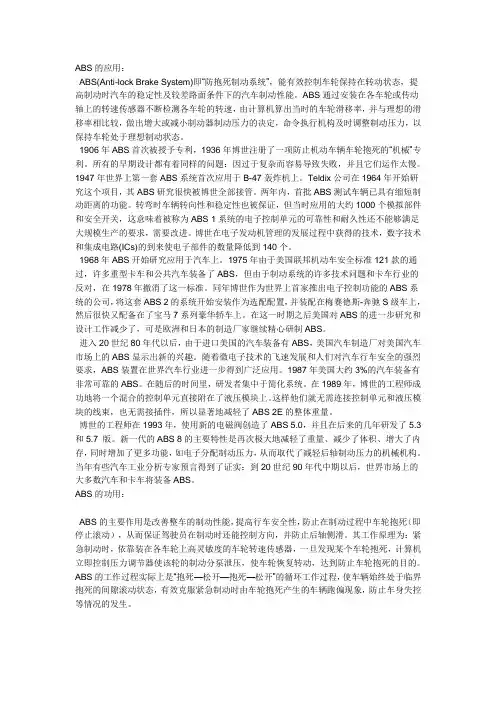
ABS的应用:ABS(Anti-lock Brake System)即“防抱死制动系统”,能有效控制车轮保持在转动状态,提高制动时汽车的稳定性及较差路面条件下的汽车制动性能。
ABS通过安装在各车轮或传动轴上的转速传感器不断检测各车轮的转速,由计算机算出当时的车轮滑移率,并与理想的滑移率相比较,做出增大或减小制动器制动压力的决定,命令执行机构及时调整制动压力,以保持车轮处于理想制动状态。
1906年ABS首次被授予专利,1936年博世注册了一项防止机动车辆车轮抱死的“机械”专利。
所有的早期设计都有着同样的问题:因过于复杂而容易导致失败,并且它们运作太慢。
1947年世界上第一套ABS系统首次应用于B-47轰炸机上。
Teldix公司在1964年开始研究这个项目,其ABS研究很快被博世全部接管。
两年内,首批ABS测试车辆已具有缩短制动距离的功能。
转弯时车辆转向性和稳定性也被保证,但当时应用的大约1000个模拟部件和安全开关,这意味着被称为ABS 1系统的电子控制单元的可靠性和耐久性还不能够满足大规模生产的要求,需要改进。
博世在电子发动机管理的发展过程中获得的技术,数字技术和集成电路(ICs)的到来使电子部件的数量降低到140个。
1968年ABS开始研究应用于汽车上。
1975年由于美国联邦机动车安全标准121款的通过,许多重型卡车和公共汽车装备了ABS,但由于制动系统的许多技术问题和卡车行业的反对,在1978年撤消了这一标准。
同年博世作为世界上首家推出电子控制功能的ABS系统的公司,将这套ABS 2的系统开始安装作为选配配置,并装配在梅赛德斯-奔驰S级车上,然后很快又配备在了宝马7系列豪华轿车上。
在这一时期之后美国对ABS的进一步研究和设计工作减少了,可是欧洲和日本的制造厂家继续精心研制ABS。
进入20世纪80年代以后,由于进口美国的汽车装备有ABS,美国汽车制造厂对美国汽车市场上的ABS显示出新的兴趣。
随着微电子技术的飞速发展和人们对汽车行车安全的强烈要求,ABS装置在世界汽车行业进一步得到广泛应用。
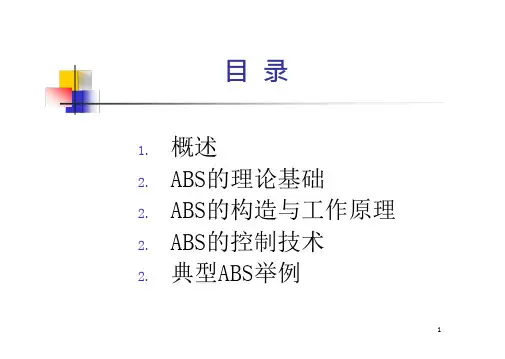

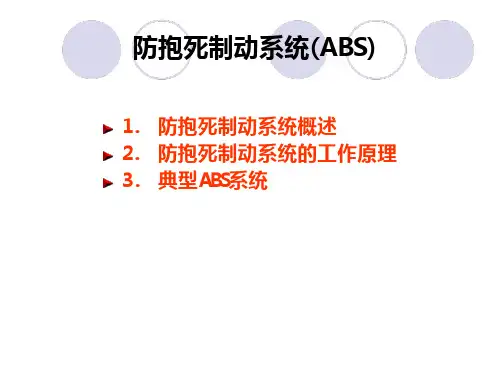
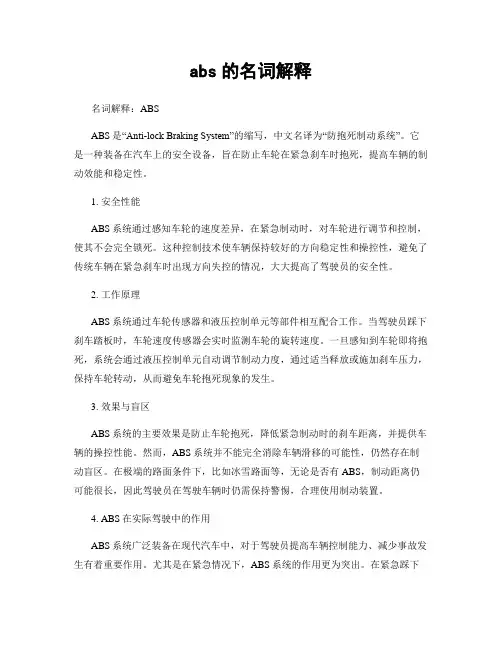
abs的名词解释名词解释:ABSABS是“Anti-lock Braking System”的缩写,中文名译为“防抱死制动系统”。
它是一种装备在汽车上的安全设备,旨在防止车轮在紧急刹车时抱死,提高车辆的制动效能和稳定性。
1. 安全性能ABS系统通过感知车轮的速度差异,在紧急制动时,对车轮进行调节和控制,使其不会完全锁死。
这种控制技术使车辆保持较好的方向稳定性和操控性,避免了传统车辆在紧急刹车时出现方向失控的情况,大大提高了驾驶员的安全性。
2. 工作原理ABS系统通过车轮传感器和液压控制单元等部件相互配合工作。
当驾驶员踩下刹车踏板时,车轮速度传感器会实时监测车轮的旋转速度。
一旦感知到车轮即将抱死,系统会通过液压控制单元自动调节制动力度,通过适当释放或施加刹车压力,保持车轮转动,从而避免车轮抱死现象的发生。
3. 效果与盲区ABS系统的主要效果是防止车轮抱死,降低紧急制动时的刹车距离,并提供车辆的操控性能。
然而,ABS系统并不能完全消除车辆滑移的可能性,仍然存在制动盲区。
在极端的路面条件下,比如冰雪路面等,无论是否有ABS,制动距离仍可能很长,因此驾驶员在驾驶车辆时仍需保持警惕,合理使用制动装置。
4. ABS在实际驾驶中的作用ABS系统广泛装备在现代汽车中,对于驾驶员提高车辆控制能力、减少事故发生有着重要作用。
尤其是在紧急情况下,ABS系统的作用更为突出。
在紧急踩下刹车踏板时,ABS会迅速切断制动皮质,释放相关制动系统,使车轮恢复旋转状态,并根据所需制动力度调整制动压力。
这种动态的制动控制可以帮助驾驶员避免车辆失控,有效提高了行车安全性。
5. ABS的进一步发展随着科技的进步和汽车工业的发展,ABS系统不断升级和改进。
现代的ABS 系统已经具备了更加精确的控制能力和更高的稳定性。
同时,一些汽车制造商还加入了电子制动力分配系统以及牵引力控制系统等功能,进一步提高了车辆的稳定性和操控性能。
这些技术的不断发展使ABS已成为现代汽车不可或缺的安全装备之一。
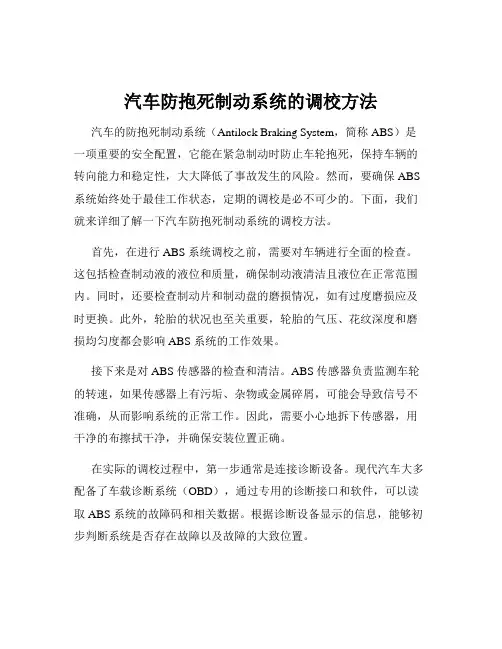
汽车防抱死制动系统的调校方法汽车的防抱死制动系统(Antilock Braking System,简称 ABS)是一项重要的安全配置,它能在紧急制动时防止车轮抱死,保持车辆的转向能力和稳定性,大大降低了事故发生的风险。
然而,要确保 ABS 系统始终处于最佳工作状态,定期的调校是必不可少的。
下面,我们就来详细了解一下汽车防抱死制动系统的调校方法。
首先,在进行 ABS 系统调校之前,需要对车辆进行全面的检查。
这包括检查制动液的液位和质量,确保制动液清洁且液位在正常范围内。
同时,还要检查制动片和制动盘的磨损情况,如有过度磨损应及时更换。
此外,轮胎的状况也至关重要,轮胎的气压、花纹深度和磨损均匀度都会影响 ABS 系统的工作效果。
接下来是对 ABS 传感器的检查和清洁。
ABS 传感器负责监测车轮的转速,如果传感器上有污垢、杂物或金属碎屑,可能会导致信号不准确,从而影响系统的正常工作。
因此,需要小心地拆下传感器,用干净的布擦拭干净,并确保安装位置正确。
在实际的调校过程中,第一步通常是连接诊断设备。
现代汽车大多配备了车载诊断系统(OBD),通过专用的诊断接口和软件,可以读取 ABS 系统的故障码和相关数据。
根据诊断设备显示的信息,能够初步判断系统是否存在故障以及故障的大致位置。
如果发现故障码,需要进一步进行故障排查。
这可能涉及到检查线路的连接是否松动、断路或短路,传感器的工作电压是否正常,以及控制单元是否能够正常接收和处理信号等。
对于一些复杂的故障,可能需要使用示波器等专业工具来检测电子信号的波形,以确定故障的具体原因。
在确认系统无故障后,就可以进行制动压力的调校。
这通常需要在专业的维修车间,使用制动压力测试仪来进行。
通过测试不同制动踏板行程下的制动压力,与车辆的技术规格进行对比,调整制动主缸的压力输出,以确保制动系统能够提供稳定且合适的制动力。
此外,还需要对 ABS 系统的控制逻辑进行校准。
这一般需要通过车辆制造商提供的专用软件来完成。
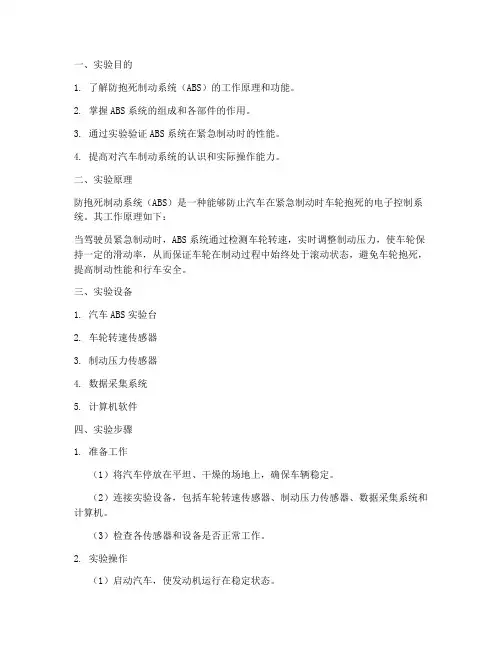
一、实验目的1. 了解防抱死制动系统(ABS)的工作原理和功能。
2. 掌握ABS系统的组成和各部件的作用。
3. 通过实验验证ABS系统在紧急制动时的性能。
4. 提高对汽车制动系统的认识和实际操作能力。
二、实验原理防抱死制动系统(ABS)是一种能够防止汽车在紧急制动时车轮抱死的电子控制系统。
其工作原理如下:当驾驶员紧急制动时,ABS系统通过检测车轮转速,实时调整制动压力,使车轮保持一定的滑动率,从而保证车轮在制动过程中始终处于滚动状态,避免车轮抱死,提高制动性能和行车安全。
三、实验设备1. 汽车ABS实验台2. 车轮转速传感器3. 制动压力传感器4. 数据采集系统5. 计算机软件四、实验步骤1. 准备工作(1)将汽车停放在平坦、干燥的场地上,确保车辆稳定。
(2)连接实验设备,包括车轮转速传感器、制动压力传感器、数据采集系统和计算机。
(3)检查各传感器和设备是否正常工作。
2. 实验操作(1)启动汽车,使发动机运行在稳定状态。
(2)打开数据采集系统,记录车轮转速和制动压力数据。
(3)进行紧急制动操作,观察车轮转速和制动压力的变化。
(4)重复实验操作,记录不同制动强度下的车轮转速和制动压力数据。
3. 数据分析(1)将实验数据导入计算机软件,进行数据处理和分析。
(2)绘制车轮转速和制动压力随时间变化的曲线。
(3)分析车轮转速和制动压力的变化规律,验证ABS系统的工作原理。
五、实验结果与分析1. 车轮转速变化在紧急制动过程中,车轮转速迅速下降,当车轮即将抱死时,转速下降至最低点。
随后,ABS系统通过调整制动压力,使车轮转速逐渐回升,保持在一定的滑动率范围内。
2. 制动压力变化在紧急制动过程中,制动压力先迅速上升,随后在ABS系统的控制下,制动压力在车轮即将抱死时达到最大值,随后逐渐下降,使车轮转速回升。
3. 实验结论通过实验验证,防抱死制动系统(ABS)在紧急制动过程中能够有效防止车轮抱死,提高制动性能和行车安全。
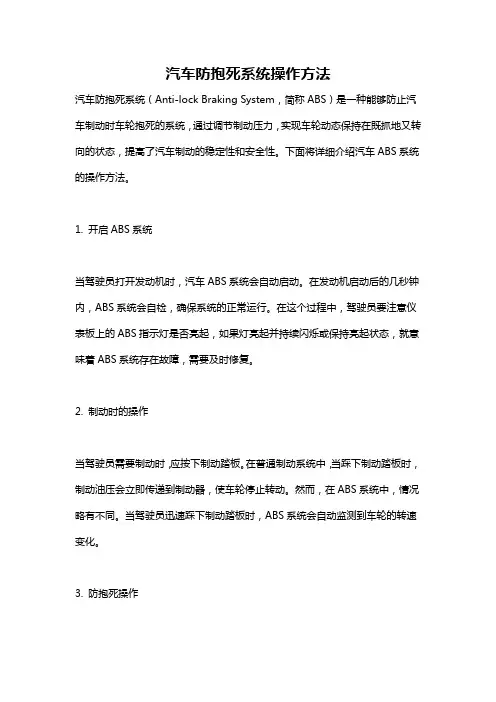
汽车防抱死系统操作方法汽车防抱死系统(Anti-lock Braking System,简称ABS)是一种能够防止汽车制动时车轮抱死的系统,通过调节制动压力,实现车轮动态保持在既抓地又转向的状态,提高了汽车制动的稳定性和安全性。
下面将详细介绍汽车ABS系统的操作方法。
1. 开启ABS系统当驾驶员打开发动机时,汽车ABS系统会自动启动。
在发动机启动后的几秒钟内,ABS系统会自检,确保系统的正常运行。
在这个过程中,驾驶员要注意仪表板上的ABS指示灯是否亮起,如果灯亮起并持续闪烁或保持亮起状态,就意味着ABS系统存在故障,需要及时修复。
2. 制动时的操作当驾驶员需要制动时,应按下制动踏板。
在普通制动系统中,当踩下制动踏板时,制动油压会立即传递到制动器,使车轮停止转动。
然而,在ABS系统中,情况略有不同。
当驾驶员迅速踩下制动踏板时,ABS系统会自动监测到车轮的转速变化。
3. 防抱死操作一旦ABS系统检测到其中一个车轮即将抱死,它会迅速调节制动压力,使车轮保持既抓地又转向的状态。
这是通过ABS系统中的传感器和阀门来实现的。
传感器可以测量车轮的转速,并将数据传输给控制单元。
然后控制单元将根据数据调节制动压力。
4. 刹车踏板的震动在防止车轮抱死的过程中,驾驶员可能会感受到刹车踏板的轻微震动。
这是正常现象,意味着ABS系统在工作中,并且有效地防止了车轮抱死。
驾驶员应保持稳定的踩下制动踏板,不要因为震动而松开或不断踩下。
5. 维持正确的制动压力在使用ABS系统时,驾驶员应尽量保持踩下制动踏板,不要松开或不断踩下。
ABS系统通过控制制动压力来保持车轮的转动状态,松开制动踏板会导致制动压力下降,车轮可能会抱死。
6.驾驶员的注意事项在使用ABS系统时,驾驶员应注意以下事项:- 在必要时,及时维修故障的ABS系统,确保其正常运行。
- 不要过分依赖ABS系统,仍需根据实际情况合理使用制动踏板。
- 在不同路况和驾驶环境中,了解和理解ABS系统的工作原理,以便更好地使用和操作。
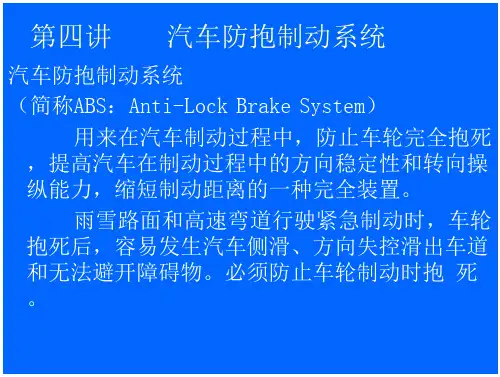
常见汽车安全系统缩写名词解释ABS刹车防抱死系统ABS(Anti-lockBrakingSystem)防抱死制动系统,通过安装在车轮上的传感器发出车轮将被抱死的信号,控制器指令调节器降低该车轮制动缸的油压,减小制动力矩,经一定时间后,再恢复原有的油压,不断的这样循环(每秒可达5~10次),始终使车轮处于转动状态而又有最大的制动力矩。
没有安装ABS的汽车,在行驶中如果用力踩下制动踏板,车轮转速会急速降低,当制动力超过车轮与地面的摩擦力时,车轮就会被抱死,完全抱死的车轮会使轮胎与地面的摩擦力下降,如果前轮被抱死,驾驶员就无法控制车辆的行驶方向,如果后轮被抱死,就极容易出现侧滑现象。
ABS这种最初被应用于飞机上的技术,现在已经十分普及,在十万元以上级别的轿车上都可见到它的踪影,有些大客车上也装有ABS。
装有ABS的车辆在遇到积雪、冰冻或雨天等打滑路面时,可放心的操纵方向盘,进行制动。
它不仅有效的防止了事故的发生,还能减少对轮胎的摩损,但它并不能使汽车缩短制动距离,在某些情况下反而会有所增加。
提示:在遇到紧急情况时,制动踏板一定要踩到底,才能激活ABS系统,这时制动踏板会有一些抖动,有时还会有一些声音,但也不能松开,这表明ABS系统开始起作用了。
EBD制动力自动分配EBD的英文全称是ElectronicBrakeforceDistribution,即电子制动力分配装置。
汽车在制动时,因为四只轮胎所附着的地面条件不同,其与地面的摩擦力也不同,制动时就容易产生打滑、倾斜和侧翻等现象,为了有效的避免这种现象,电子制动力分配装置就应运而生,它的作用就是在汽车制动的瞬间,通过对四只轮胎附着的不同地面情况进行感应、计算,得出不同的磨擦力数值,使四只轮胎的制动装置根据不同的情况用不同的方式和力量制动,并在运动中不断高速调整,从而保证车辆的平稳、安全。
有人认为EBD比ABS先进很多,其实不然。
从技术实现上,EBD仅仅是在ABS的控制电脑里增加一个控制软件,机械系统与ABS完全一致。
abs组成及工作原理
abs即为防抱死制动系统(Anti-lock Braking System)的英文
缩写。
它是一种车辆制动系统,可以防止车轮在制动时完全锁死,保持车辆的稳定性。
工作原理:
ABS系统通过传感器、控制单元和执行装置等组件相互配合,实现防止车轮锁死的功能。
1. 传感器:ABS系统内置了轮速传感器,用于检测每个车轮
的转速,并将传感器信号传输给控制单元。
2. 控制单元:控制单元根据每个车轮的转速来进行计算和比较,判断车轮是否即将锁死。
3. 执行装置:当控制单元检测到车轮即将锁死时,会通过执行装置调整制动力的分配。
执行装置通常由制动压力调节器和液压泵组成。
当车轮开始锁死时,制动压力调节器会减小制动力,液压泵则会增加制动液压力。
通过以上组件的协调工作,ABS系统实现了在车轮即将锁死
之前,智能地调节制动力分配,避免车轮完全锁死。
这样可以使车辆保持较好的操控性能和稳定性,避免因制动过度而导致车辆失控的情况发生。
它利用了车轮转速的变化检测机制,能够实时监测车轮的转速,一旦发现某个车轮即将锁死,系统会立即调整制动力分配,使
之保持在安全范围内。
这种防止车轮锁死的技术在紧急制动和避免制动时,能够提供更稳定的制动效果,增加驾驶员对车辆的控制能力,提高行驶安全性。
汽车abs防抱死原理
汽车防抱死制动系统(ABS)是在传统的液压制动基础上发展起来的一种新型制动系统。
它主要由两部分组成,即发动机、制动器、轮胎和液压控制阀。
当车轮发生抱死时,制动器和发动机会向车轮施加反向压力,以使车轮制动抱死。
但此时的制动力矩仍足以使汽车恢复正常行驶,而不发生侧滑,而且还可以防止轮胎打滑。
当ABS工作时,它能实时监测各车轮的轮速,当车轮发生抱死时,它就会控制液压控制阀改变液压流量。
在制动力矩的作用下,制动力矩不会被轮胎的抱死所抵消。
此时车轮仍可以正常工作而不发生侧滑。
由于ABS系统在车轮制动抱死时仍能保证汽车正常行驶,所以它被称为防抱死制动系统。
ABS的工作原理是:在刹车踏板上施加一个压力,当它接近或达到最大压力时(一般为30kPa),压力传感器就会向ABS控制电脑发出信号。
控制电脑根据压力传感器的信号来判断当前的制动踏板位置、速度和车辆状态等信息。
如果车轮即将抱死,则制动压力增大;如果车轮即将抱死,则制动压力减小。
—— 1 —1 —。
ABSEBSESC产品介绍1.ABS(防抱死制动系统):ABS是车辆安全系统的一种主动安全装备,主要用于防止车辆在紧急制动时出现轮胎抱死现象,确保车辆制动时仍能保持最佳的方向稳定性和操控性。
ABS通过对车轮的制动力进行连续调节,使车轮在紧急制动时保持旋转,避免车轮因抱死而失去了方向控制。
ABS工作原理是通过传感器感知车轮速度,再通过制动阀门控制制动液的流向,实现对车轮的制动力调节。
当车辆紧急制动时,系统会周期性释放和恢复制动力,以保持车轮不抱死。
这样的连续调节可以减少制动力对车轮的阻滞,提高车辆的制动距离和稳定性,避免碰撞和失控事故的发生。
2.EBS(电子制动系统):EBS是一种电子化的制动系统,用于替代传统的气压制动系统。
EBS采用了电子控制单元(ECU)来控制制动阀门,消除了传统气压制动系统中的机械和气压元件,提高了制动系统的响应速度和精度。
EBS可以实现多路制动、自适应制动以及制动力的主动分配。
EBS的工作原理是通过ECU控制制动阀门的开启和关闭,从而控制制动气压的大小。
当车辆需要制动时,ECU会根据车辆的状态和司机的操作信号计算出合适的制动力,并相应地控制制动阀门的开度,从而实现对车轮制动力的控制。
EBS不仅提高了制动响应速度和稳定性,还可以通过传感器实时监测制动系统的状态,提供车辆的制动性能反馈和预警信息。
3.ESC(电子稳定控制系统):ESC是一种综合性的车辆动态稳定控制系统,可以通过对车辆各项参数的监测和控制来实现对车辆行驶稳定性的提升。
ESC可以感知车辆中心轴线与实际运动轨迹之间的差异,并通过自动控制制动力和发动机输出力矩来纠正车辆的姿态,避免侧滑、失控和翻车等危险情况。
ESC的工作原理是通过传感器实时监测车辆的姿态参数,如横向加速度、转向角度、车速等,并通过电子控制单元对制动系统和发动机输出力矩进行调节。
当车辆出现侧滑或失控现象时,ESC系统会自动调整车轮制动力和发动机输出力矩,以使车辆恢复到安全的行驶状态。
2024年汽车防抱死系统市场分析现状概述汽车防抱死系统(Anti-Lock Braking System,简称ABS)是一种能够防止车辆在紧急制动时车轮封锁的安全系统。
该系统能够有效地提高车辆制动时的操控性和稳定性,减少了车辆在制动过程中打滑或失控的风险,从而提高驾驶者的安全性。
本文将对全球汽车防抱死系统市场的现状进行分析,包括市场规模、市场增长趋势、竞争格局和主要市场驱动因素等。
市场规模近年来,随着人们对汽车安全性的重视程度不断提高,汽车防抱死系统市场呈现出快速增长的趋势。
根据市场研究公司的数据,全球汽车防抱死系统市场在2019年的规模约为100亿美元。
市场增长趋势1.技术升级:随着汽车制造技术的不断发展,汽车防抱死系统也在不断升级。
新一代的ABS系统不仅具备防抱死的基本功能,还加入了更多智能化和自动化的特性,如电子制动力分配(EBD)和牵引力控制系统(TCS)等。
这些技术的应用提高了汽车制动系统的效能,进一步推动了市场增长。
2.政府法规推动:为了提升道路交通安全水平,许多国家和地区已经出台了强制性的汽车安全标准,其中包括对汽车制动系统的要求。
这些法规的引入使得汽车制造商不得不在新车上安装ABS系统,从而推动了市场的增长。
3.消费者安全意识提升:随着消费者对汽车安全性的关注和认知度的提高,他们对于安全配置的要求也越来越高。
ABS系统作为一项关键的被动安全配置,受到了消费者的广泛认可。
消费者对车辆安全性的需求推动了ABS市场的需求增长。
竞争格局目前,全球汽车防抱死系统市场存在着许多竞争激烈的厂商。
市场竞争主要集中在几家大型汽车零部件供应商中,他们通过不断的创新和技术研发来提高产品性能和功能。
同时,市场进入壁垒也较高,新进入者面临着巨大的技术和资金难题,限制了市场的竞争程度。
主要市场驱动因素1.不断增长的汽车产量:随着全球交通需求的不断增长,汽车产量也在持续增加。
增长的汽车产量为汽车防抱死系统市场提供了巨大的需求,推动了市场的扩大。
汽车防抱死制动系统(ABS )摘要:本文简要介绍了汽车防抱死制动系统(Anti-lock Braking System ,简称ABS )的控制原理,对目前汽车防抱死制动系统所采用的控制技术进行了综述,并对其发展趋势进行了预测。
关键词:汽车;防抱死制动系统;控制技术1.概述随着汽车工业的迅猛发展和高速公路的不断修建,汽车的行驶安全性越来越为人们重视。
为了全面满足制动过程中汽车对制动的要求,使制动器制动力分配更趋合理。
汽车防抱死制动系统(简称ABS )已越来越多地应用在汽车上。
“ABS”中文译为“防锁死刹车系统”.它是一种具有防滑、防锁死等优点的汽车安全控制系统。
ABS 是常规刹车装置基础上的改进型技术,可分机械式和电子式两种。
现代汽车上大量安装防抱死制动系统,ABS 既有普通制动系统的制动功能,又能防止车轮锁死,使汽车在制动状态下仍能转向,保证汽车的制动方向稳定性,防止产生侧滑和跑偏,是目前汽车上最先进、制动效果最佳的制动装置。
普通制动系统在湿滑路面上制动,或在紧急制动的时候,车轮容易因制动力超过轮胎与地面的摩擦力而安全抱死。
汽车防抱死制动系统是指汽车在制动过程中能实时判定车轮的滑动率,自动调节作用在车轮上的制动力矩,防止车轮抱死。
从而获得最佳制动效能的电子装置。
它能把车轮的滑动率控制在一定的范围之内,充分地利用轮胎与路面之间的附着力,有效地缩短制动距离,显著地提高车辆制动时的可操纵性和稳定性,从而避免了车轮抱死时易出现的各种交通事故。
随着制动强度的增加,车轮滚动成分越来越少,而滑动成分越来越多,一般用滑动率S 来说明制动过程中滑动成分的多少。
滑动率越大,滑动成分越少。
S=1-ur ω%100⨯ 其中: u ——车轮中心的速度;r ——没有地面制动力时的车轮滚动半径; w ——车轮的角速度。
纵向和侧向附着系数可表达为车轮滑动率的函数(如图1)。
最大纵向附着系数所对应的滑动率称为临界稳定点SK 。
根据控制理论把滑动率小于SK 的区域称为稳定制动区,SK 以后的为非稳定制动区。
ABS 正是利用道路与轮胎之间的关系,强制性地把车轮滑动率控制在临界稳定点SK 附近,使路面附着性能得到最充分的发挥,从而达到最佳的制动效果。
图1 附着系数-滑动率曲线目前所采用的ABS 主要由轮速传感器,电子控制单元,压力控制阀和线束、管路等附件组成。
ABS 的开发主要是研究设计优化运算和控制程序软件,实现实时精确制动调节的技术,同时提高硬件的水平。
2.目前ABS 所采用的控制技术ABS 的控制效果很大程度上取决于系统所采用的控制技术[4]。
目前所采用的主要是逻辑门限值控制技术。
为进一步提高ABS 的性能,还提出了一些基于滑动率的控制技术,如PID 控制,滑动模态变结构控制,模糊控制等。
每种控制均以不同的控制规律逼近期望的点。
2.1 PID 控制定义期望滑动率S0 与实际滑动率S 之差为控制误差e=S-S0,则PID 的控制规律可表示为:te d l p d d K edt K e K U ⎰++= 因此,ABS 控制器的设计最后就归结为,根据ABS 动态系统,确定出一组最佳的参数Kp 、Ki 和Kd ,使车轮的滑动率以最快的方式逼近设定目标S0。
2.2 滑动模态变结构控制由汽车防抱死制动的基本原理可知,其制动过程的本质问题是把车轮的滑动率控制在附着系数的峰值点Sk ,则滑动模态变结构根据系统当时的状态、偏差及其导数值,在不同的控制区域,以理想开关的方式切换控制量的大小和符号,以保证系统在滑动区域很小的范围内,状态轨迹(S ,×S)沿滑动换节曲线滑向控制目标(Sk ,0)。
通常取制动力矩为控制变量U ,切换条件为:⎪⎩⎪⎨⎧<>=--~~00v M v M U b b其中 Mb- 、Mb+分别代表由调节系统所决定的制动力矩减少、增加两种不同的状态。
e c e v 1~+=∙为切换函数,e=S -Sk 为实际滑动率相对目标点的偏差。
2.3 模糊控制对于以滑动率为控制对象的防抱死制动系统,其输入量取期望滑动率与车轮实际滑动率的偏差E 以及偏差的变化率EC ,输出量为制动管路油压。
采用带修正因子的模糊控制器,把用模糊推理算法形成的控制表概括为一个解析式:U =α × E + (1-α)EC其中α为修正因子,α值的大小直接反映了对偏差及偏差变化率的加权程度。
通过调整修正因子α,就可以改变控制规则。
当α较大时,表明对偏差的加权大,阶跃响应快,控制能量主要用于减少偏差,但易出现超调;当α较小时,控制目的是减少超调,但响应过程较慢。
通常采用带两个α值的修正因子表达式就可满足性能要求,即:⎩⎨⎧-+-+=较大时当较小时当E EC a E a E EC a E a u )1()1(2211 其中,修正因子α1 、α2∈(0,1)且α1<α2 ,控制系统在判断E 值的大小之后,选择控制规则表达式。
2.4 逻辑门限值控制此方法预先对若干个控制参数设定一些控制极限(门限)值,制动时,根据计算的实时参数值与对应门限值的大小关系,来判定车轮的运动状态,从而控制调节制动压力,以获取足够大的制动强度和良好的方向稳定性。
常作为ABS 控制参数的有:车轮滑移率S ,车轮转动的角加(减)速度ω及其变化率.ω等三种描述车轮运动情况或动力学状态的参数。
由于仅用一个控制参数难于保证ABS 在各种行驶条件下都具有良好的性能,因此,目前逻辑门限值控制方法通常将车轮转动的角加(减)速度作为主要控制参数,而将车轮的滑动率S 作为辅助控制参数。
其中滑动率是从各轮速信号按一定逻辑确定汽车的参考速度后,计算出的参考滑动率,与实际滑动率存在着差异。
2.5双参数控制双参数控制的 ABS ,由车速传感器 ( 测速雷达 ) 、轮速传感器、控制装置 ( 电脑 ) 和执行机构组成。
其工作原理是车速传感器和轮速传感器,分别将车速和轮速信号输入电脑,由电脑计算出实际滑移率,并与理想滑移率 15 %一 20 %作比较,再通过电磁阀增减制动器的制动力。
这种曳速传感器常用多普勒测速雷达。
当汽车行驶时,多普勒雷达天线以一定频率不断向地面发射电磁波,同时又接收反射回来的电磁波,测量汽车雷达发射与接收的差值,便可以准确计算出汽车车速。
而轮速传感器装在变速器外壳,由变速器输出轴驱动,它是一个脉冲电机,所产生的频率与轮速成正比。
执行机构由电磁阀及继电器等组成。
电磁阀调整制动力,以便保持理想的滑移率。
这种ABS 可保证滑移率的理想控制,防抱制动性能好,但由于增加了一个测速雷达,因此结构较复杂,成本也较高。
2.6单参数控制它以控制车轮的角减速度为对象,控制车轮的制动力,实现防抱死制动,其结构主要由轮速传感器、控制器 ( 电脑 ) 及电磁阀组成。
为了准确无误地测量轮速,传感头与车轮齿圈间应留有 1mm 间隙。
为避免水、泥、灰尘对传感器的影响,安装前应将传感器加注黄油。
电磁阀用于车轮制动器的压力调节。
对于四通道制动系统,一个车轮圈有一个电磁阀;三通道制动系统,每个前轮拥有一个,两个后轮共用一个。
电磁阀有三个液压孔,分别与制动主缸与车轮制动分缸相连,并能实现压力升高、压力保持、压力降低的调压功能。
工作原理如下: 1) 升压在电磁阀不工作时,制动主缸接口和各制动分缸接口直通。
由于主弹簧强度大,使进油阀开启,制动器压力增加。
2) 压力保持当车轮的制动分缸中的压力增长到一定值时,进油阀切断关闭。
支架就保持在中间状态,三个孔间相互密封,保持制动压力。
3) 降压当电磁阀工作时,支架克服两个弹簧的弹力,打开卸荷肉使制动分缸压力降低。
压力一旦降低,电磁阀就转换到压力保持状态,或升压的准备状态。
控制装置 ECU 的主要任务是把各车轮的传感器传回来的信号进行计算、分析、放大和判别,再由输出级将指令信号输出到电磁阀,去执行制动压力调节任务。
电子控制装置,由四大部分组成,输入级 A 、控制器 B 、输出级 C ,稳压与保护装置 D 。
电子控制器以 4 一 101tz 的频率驱动电磁阀,这是驾驶员无法做到的。
这种单参数控制方式的 ABS ,由于结构简单、成本低,故目前使用较广。
在美国克莱斯勒型高级轿车中大多配备了这种单参数控制方式的 ABS 。
它在轿车的四个轮上都装有轮速传感器。
在车轮轴上安装有 45 齿或 100 齿的齿圈,轮速传感器的传感头装在齿圈的顶上。
当车轮转动时,使传感器不断产生电压信号,并输入电脑,与 RoM 中理想速度比较,算出车轮的增速或减速,向电磁阀发出升压或卸压的指令,以控制制动分缸制动力。
3. ABS 使用中注意的问题1) 更换制动器或更换液压制动系部件后,应排净制动管路中的空气,以免影响制动系统的正常工作。
2) 装有 ABS 的汽车,每年应更换一次制动液。
否则,制动液吸湿性很强,含水后不仅会降低沸点,产生腐蚀,而且还会造成制动效能衰退。
3) 检查 ABS 防抱死制动系统前应先拔去电源。
4. 发展趋势采用逻辑门限值控制算法,可避免一系列繁杂的理论分析和对一些不确定因素的定量计量。
简化了控制器的设计,而且因仅需测定车轮的角速度,便于实现,所以装车成本低。
该算法现已趋近成熟,为当前汽车ABS 系统所普遍采用,但它并非最佳的控制算法。
由于不同路况下各种门限值及保压时间都是经过反复试验得出的经验数值,没有十分明确的理论依据,故ABS 开发的周期长,且控制品质难以保证。
基于滑动率的控制算法容易实现连续控制,且有十分明确的理论加以指导,但目前制约其发展的瓶颈主要是实现的成本问题,根据我们的研究认为,今后ABS 控制算法的发展方向将在以下几方面。
(1) 针对当前广泛采用的逻辑门限值控制算法所存在的缺点,研究能跟踪路面特性变化,使ABS 各项性能指标始终处于最佳状态的控制算法。
其中预测控制技术值得重视。
由于在制动过程中,轮胎与路面间的摩擦特性导致防抱死制动系统具有非常明显的非线性、时变性和不确定性。
因而难于建立其精确的数学模型,而预测控制具有预测模型、滚动优化和反馈校正的基本特性,可根据某一优化指标设计控制系统,确定一个控制量的时间序列,使未来一段时间内被调量与经过柔化后的期望轨迹之间的误差为最小。
由于该算法采用的是不断在线滚动优化,且在优化过程中不断通过实测系统输出与预测模型输出的误差来进行反馈校正,所以能在一定程度上克服由于预测模型误差和某些不确定性干扰等的影响,使系统的鲁棒性得到增强。
(2) 随着体积更小,价格更便宜,可靠性更高的车速传感器的出现,ABS 系统中增加车速传感器成为可能,确定车轮滑动率将变得准确而快速。
其中非接触式的车速传感器(如光电式、多谱勒仪等)今后最有可能应用于汽车ABS 系统中。
此时基于滑动率的控制算法就可被重视。